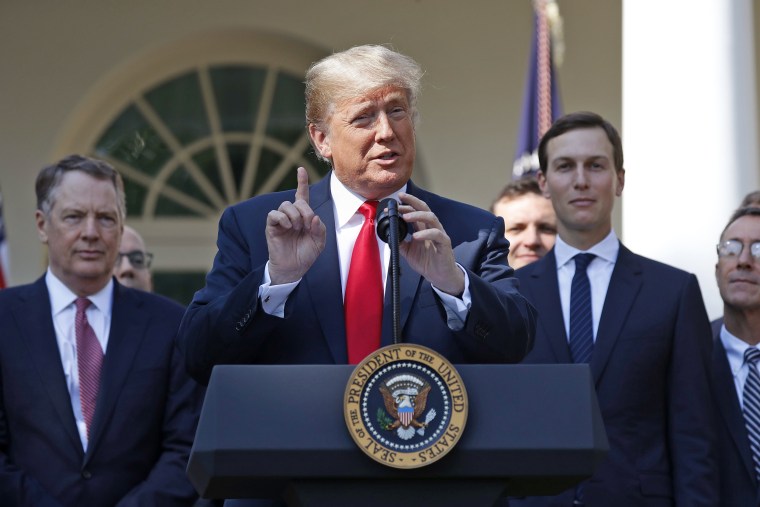If President Trump is correct, the new and supposedly improved North American Free Trade Agreement — inelegantly renamed the United States-Mexico-Canada Agreement by Trump — is a “historic transaction.” Like, what, the Louisiana Purchase or the 1848 Treaty of Guadalupe Hidalgo or some such?
Maybe a lowering of expectations is called for here. To believe that the agreement is even just a good, solid deal for the American people requires accepting several things to be true that almost certainly aren’t — despite what the president has said in the past.
First, the president has claimed that NAFTA Classic, signed in December 1993 by President Clinton, was the worst trade deal in American history. Of course, maybe by “worst’ what Trump means is that all the U.S. trade deals have been pretty good and NAFTA was really just the least pretty good — kind like how “Solo” is the worst “Star Wars” film but is actually totally fine, especially as a rental.
But obviously that is not what Trump means. His (perhaps sole) long-held, core economic belief is that decades of dumb trade deals such as NAFTA have impoverished America. Recall that, as a presidential candidate, Trump said America was once “a very powerful, very wealthy country. And we're a poor country now.” (Actually, U.S. household net worth is over $100 trillion and middle-class median incomes, adjusted for inflation, are up 42 percent since 1979.)
NAFTA has been a gentle tailwind pushing the economy forward: A research review by the Congressional Budget Office found that NAFTA and other U.S. trade agreements overall boosted growth, worker productivity and wages. And a University of Chicago survey of top economists found that 96 percent agree or strongly agree that, on average, Americans have been “better off” with NAFTA than if the previous trade rules had remained in place.
It’s also just odd to think NAFTA could really have ruined the U.S. economy when the combined Canadian and Mexican economies are only an eighth the size of America’s.
And, although Trump claims NAFTA 2.0 “greatly opens markets to our farmers and manufacturers, [and] reduces trade barriers to the U.S.,” that was already the case with NAFTA 1.0: The whole point of the agreement was to make the entire region a free-trade zone.
And it worked wonderfully, tripling trade flows between the three nations to more than $1 trillion.
One notable but really minor exception was Canadian dairy tariffs, supposedly one of the big reasons we needed to renegotiate NAFTA and a sticking point up until the very end. Under the new deal, American farmers will have greater access to the Canadian dairy market, but possible additional exports of a few hundred million dollars annually are a rounding error in a $700 billion U.S.-Canada trading relationship. Likewise, the boost for U.S. auto manufacturers and workers from requiring that more of the value of vehicle content — to 75 percent from the current 62.5 percent — be from the region is likely to be modest.
So why, then, did investors and business groups seem so happy with the new deal if it was only a minor tweaking of the old one? Simple: Cosmetic changes, even if they make the deal a bit worse in some places, are vastly preferable to the U.S. leaving NAFTA or hitting Canada with auto tariffs if it continued to reject the U.S. proposal. In other words, Trump is taking credit for eliminating the uncertainty that he created, much like a firefighter who douses the fire he started and then wants a medal from the mayor.
Trump’s hype about the USMCA might make a bit more sense if you think of the deal as some masterstroke of geopolitics that gives America the clear upper-hand in its escalating trade conflict with China. And it might be somewhat helpful to that dispute, given that settling the NAFTA reboot will focus our efforts over there. Plus, according to Trump, the agreement will allow the U.S. to “reclaim a supply chain that has been offshored to the world,” given our tariffs on imports from China that make many things more expensive and the elimination of a potential trade war in North America (which Trump had caused in the first place). Both might make North America, and the U.S. in particular, a more desirable place for companies to build factories instead of Asia.
Then again, China may see the superficial changes made to NAFTA — as well as those in the recently revamped U.S.-Korea free trade agreement — and question whether Team Trump really wants China to make major changes to its economic policies as much as tell Americans that he convinced them to do so. As the consulting firm Capital Economics notes, “[The USMCA] provides another example of President Donald Trump backing down from his hard-line protectionist threats in return for modest concessions that allow him to claim victory.”
“The Art of the Deal,” it seems, might just be making one, instead of making a good one.




